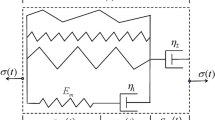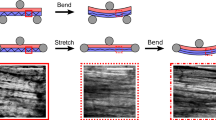Abstract
Human spine ligaments show a highly non-linear, strain rate dependent biomechanical behavior under tensile tests. A visco-hyperelastic fiber-reinforced constitutive model was accordingly developed for human ligaments, in which the energy density function is decomposed into two parts. The first part represents the elastic strain energy stored in the soft tissue, and the second part denotes the energy dissipated due to its inherent viscous characteristics. The model is applied to various human spinal ligaments including the anterior and posterior longitudinal ligaments, ligamentum flavum, capsular ligament, and interspinous ligament. Material parameters for each type of ligament were obtained by curve-fitting with corresponding experimental data available in the literature. The results indicate that the model presented here can properly characterize the visco-hyperelastic biomechanical behavior of human spine ligaments.





Similar content being viewed by others
References
Oza, A., Vanderby, R., & Lakes, R. (2006). Mechanics of Biological Tissue (pp. 379–397)., Creep and relaxation in ligament: Theory, methods and experiment Boca Raton: Taylor and Francis.
Dvorak, J., Panjabi, M., Gerber, M., & Wichmann, W. (1987). CT-functional diagnostics of the rotatory instability of upper cervical spine: 1. An experimental study on cadavers. Spine, 12, 197–205.
Levine, A. M., & Edwards, C. C. (1989). Traumatic lesions of the occipitoatlantoaxial complex. Clinical Orthopaedics and Related Research, 239, 53.
Alexander, R. M. N. (1984). Elastic energy stores in running vertebrates. American Zoologist, 24, 85–94.
Silver, F. H. (1987). Biological materials: structure, mechanical properties and modeling of soft tissues. New York: New York University Press.
White, A. A., & Panjabi, M. M. (1990). Clinical biomechanics of the spine (2nd ed.). Philadelphia: Lippincott.
Myklebust, J. B., Pintar, F., Yoganandan, N., Cusick, J. F., Maiman, D., Myers, T. J., et al. (1988). Tensile strength of spinal ligaments. Spine, 13, 526–531.
Fung, Y. C. (1973). Biorheology of soft tissues. Biorheology., 10, 139–155.
Pioletti, D. P., & Rakotomanana, L. R. (2000). Non-linear viscoelastic laws for soft biological tissues. European Journal of Mechanics a-Solids., 19, 749–759.
Gray, H. (1918). Anatomy of the human body. Philadelphia: Lea Febiger.
Tsuang, Y. H., Chiang, Y. F., Hung, C. Y., Wei, H. W., Huang, C. H., & Cheng, C. K. (2009). Comparison of cage application modality in posterior lumbar interbody fusion with posterior instrumentation—A finite element study. Medical Engineering & Physics, 31, 565–570.
Pitzen, T., Geisler, F., Matthis, D., Müller-Storz, H., Barbier, D., Steudel, W. I., et al. (2002). A finite element model for predicting the biomechanical behaviour of the human lumbar spine. Control Engineering Practice, 10, 83–90.
Toosizadeh, N., & Haghpanahi, M. (2011). Generating a finite element model of the cervical spine: Estimating muscle forces and internal loads. Scientia Iranica, 18, 1237–1245.
Zhang, Q. H., Teo, E. C., Ng, H. W., & Lee, V. S. (2006). Finite element analysis of moment-rotation relationships for human cervical spine. Journal of Biomechanics, 39, 189–193.
Spencer, A. J. M. (1984). Continuum theory of the mechanics of fibre-reinforced composites. New York: Springer.
Peng, X., Guo, Z., & Moran, B. (2006). An anisotropic hyperelastic constitutive model with fiber-matrix shear interaction for the human annulus fibrosus. Journal of Applied Mechanics, 73, 815–824.
Guo, Z., Peng, X., & Moran, B. (2006). A composites-based hyperelastic constitutive model for soft tissue with application to the human annulus fibrosus. Journal of the Mechanics and Physics of Solids, 54, 1952–1971.
Sun, D. D. N., & Leong, K. W. (2004). A nonlinear hyperelastic mixture theory model for anisotropy, transport, and swelling of annulus fibrosus. Annals of Biomedical Engineering, 32, 92–102.
Natali AN, Carniel EL, Pavan PG, Dario P, Izzo I (2006) Hyperelastic models for the analysis of soft tissue mechanics: definition of constitutive parameters. Biomedical Robotics and Biomechatronics, BioRob 2006 The First IEEE/RAS-EMBS International Conference on: IEEE; p. 188–91.
Tang, H., Buehler, M. J., & Moran, B. (2009). A constitutive model of soft tissue: from nanoscale collagen to tissue continuum. Annals of Biomedical Engineering, 37, 1117–1130.
Tang, Y., Ballarini, R., Buehler, M. J., & Eppell, S. J. (2010). Deformation micromechanisms of collagen fibrils under uniaxial tension. Journal of the Royal Society, Interface, 7, 839–850.
Pioletti, D. P., Rakotomanana, L. R., & Leyvraz, P. F. (1999). Strain rate effect on the mechanical behavior of the anterior cruciate ligament-bone complex. Medical Engineering & Physics, 21, 95–100.
Ivancic, P. C., Coe, M. P., Ndu, A. B., Tominaga, Y., Carlson, E. J., & Rubin, W. (2007). Dynamic mechanical properties of intact human cervical spine ligaments. Spine Journal, 7, 659.
Mattucci, S. F. E., Moulton, J. A., Chandrashekar, N., & Cronin, D. S. (2012). Strain rate dependent properties of younger human cervical spine ligaments. Journal of the mechanical behavior of biomedical materials, 10, 216–226.
Pioletti, D. P., Rakotomanana, L., Benvenuti, J. F., & Leyvraz, P. F. (1998). Viscoelastic constitutive law in large deformations: application to human knee ligaments and tendons. Journal of Biomechanics, 31, 753–757.
García, J. J., & Cortés, D. H. (2006). A nonlinear biphasic viscohyperelastic model for articular cartilage. Journal of Biomechanics, 39, 2991–2998.
García, J. J., & Cortés, D. H. (2007). A biphasic viscohyperelastic fibril-reinforced model for articular cartilage: Formulation and comparison with experimental data. Journal of Biomechanics, 40, 1737–1744.
Schroeder, Y., Elliott, D., Wilson, W., Baaijens, F., & Huyghe, J. (2008). Experimental and model determination of human intervertebral disc osmoviscoelasticity. Journal of Orthopaedic Research, 26, 1141–1146.
Limbert, G., & Middleton, J. (2004). A transversely isotropic viscohyperelastic material: Application to the modeling of biological soft connective tissues. International Journal of Solids and Structures, 41, 4237–4260.
Limbert, G., & Middleton, J. (2006). A constitutive model of the posterior cruciate ligament. Medical Engineering & Physics, 28, 99–113.
Zhurov, A. I., Limbert, G., Aeschlimann, D. P., & Middleton, J. (2007). A constitutive model for the periodontal ligament as a compressible transversely isotropic visco-hyperelastic tissue. Computer Methods in Biomechanics and Biomedical Engineering, 10, 223–235.
Ogden, R. (1984). Non-linear elastic deformations. New York: Halsted Press.
Yang, L., Shim, V., & Lim, C. (2000). A visco-hyperelastic approach to modelling the constitutive behaviour of rubber. International Journal of Impact Engineering, 24, 545–560.
Humphrey, J., Strumpf, R., & Yin, F. (1990). Determination of a constitutive relation for passive myocardium: I. A new functional form. Journal of Biomechanical Engineering, 112, 333.
Holzapfel, G. A., Eberlein, R., Wriggers, P., & Weizsäcker, H. W. (1996). Large strain analysis of soft biological membranes: Formulation and finite element analysis. Computer Methods in Applied Mechanics and Engineering, 132, 45–61.
Hirokawa, S., & Tsuruno, R. (2000). Three-dimensional deformation and stress distribution in an analytical/computational model of the anterior cruciate ligament. Journal of Biomechanics, 33, 1069–1077.
Rao, S., Daniel, I. M., & Gdoutos, E. E. (2004). Mechanical properties and failure behavior of cord/rubber composites. Applied Composite Materials, 11, 353–375.
Beda, T. (2007). Modeling hyperelastic behavior of rubber: A novel invariant-based and a review of constitutive models. Journal of Polymer Science Part B: Polymer Physics, 45, 1713–1732.
Panjabi, M. M., Crisco, J. J., Lydon, C., & Dvorak, J. (1998). The mechanical properties of human alar and transverse ligaments at slow and fast extension rates. Clinical Biomechanics, 13, 112–120.
Natali, A., Pavan, P., Carniel, E., & Dorow, C. (2004). Viscoelastic response of the periodontal ligament: an experimental-numerical analysis. Connective Tissue Research, 45, 222–230.
Acknowledgements
The authors would like to acknowledge the support of the National Natural Science Foundation of China (50975236, 11172171) and Key Scientific and Technological Project Foundation of Chongqing, China (CSTC2012gg-yyjs10011).
Author information
Authors and Affiliations
Corresponding author
Rights and permissions
About this article
Cite this article
Jiang, Y., Wang, Y. & Peng, X. A Visco-Hyperelastic Constitutive Model for Human Spine Ligaments. Cell Biochem Biophys 71, 1147–1156 (2015). https://doi.org/10.1007/s12013-014-0322-9
Published:
Issue Date:
DOI: https://doi.org/10.1007/s12013-014-0322-9




